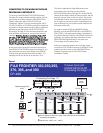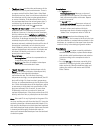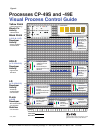
Using the KODAK EKTACOLOR Processing Cartridge 111 With Digital Minilabs, CP-48S/CP-49E CIS-229E
10
The Black Patch monitors the performance of the
developer for activity and contamination. There is
no upper control limit for Black Patch. If the Black
Patch plots are low, then it could be an indication of
low developer activity due to underreplenishment
or severe oxidation. If the blue Black Patch is very
low and separated from the red and green plots, it
could be a sign of developer contamination. See
prescriptions listed under the LD parameter.
The HD-LD (Contrast) is usually a very steady plot
parameter that is unresponsive to most process
problems. However, it can help monitor developer
activity problems due to agitation or oxidation. If
developer tank solution is underagitated, the plots
will be low. If developer tank solution is slightly
oxidized, the plots will be high. If the developer
becomes extremely oxidized, the plots will be low. If
the solution is extremely out of control by more
than 0.18density units over or under aim, drain and
replace the developer tank solution. If the plots are
less than 0.18 density units over or under aim, a
prescription can be risked
Prescriptions:
— Underagitation: call service representative to
fix agitation pump on processor.
— Oxidation: check for air bubbles in developer
tank; call service technician if seen.
The LD (Speed) monitors the developer activity.
Speed is the primary indicator of developer time,
temperature, and especially developer
replenishment rate. For time that is too long,
temperature too high, or overreplenishment, the LD
plots will be high. For time too short, temperature
too low, or underreplenishment, the LD plots will be
low. Check the temperature of the developer; adjust
as necessary to bring back into specification. If the
plots are extremely out of control, by more than
0.18 density units over or under aim, drain and
replace the developer. If the plots are less than 0.18
density units from aim, a prescription can be risked.
Note: If the red LD is very high and/or the green LD is
very low and they are split from the blue LD, it may be
caused by developer contaminated with bleach-fix. In
this case, the developer must be drained and replaced
with fresh developer tank solution. Make sure the tank
is cleaned and thoroughly flushed with water to
remove all contaminated developer from the tank and
circulation system.
Prescriptions:
— For high LD plots:
Overreplenishment: Remove a volume of
developer solution equal to 10% of the total
tank volume and replace with water. Repeat
until it is in control.
— For low LD plots:
Underreplenishment: Remove a volume of
developer tank solution equal to one third of
the tank volume and replace with fresh
developer tank that is mixed according to the
“Make 1 litre” component ratios in Table 1a.
D-min (Stain) monitors the whiteness of the
unexposed paper. An increase in the D-min plot can
indicate oxidation or contamination problems in the
developer, or a problem in the super rinse when the
solution is dirty or has biological growth residue.
Prescriptions:
— For high D-min on paper caused by oxidized or
contaminated developer, replace the developer
tank solution with fresh developer tank solution
mixed according to the component ratios in
Table 1a.
— For a high D-min on the paper caused by dirty
stabilizer or biological growth in the stabilizer
tanks and racks, clean the stabilizer tanks and
replace the solution with water and KODAK
Rinse Tablets.














